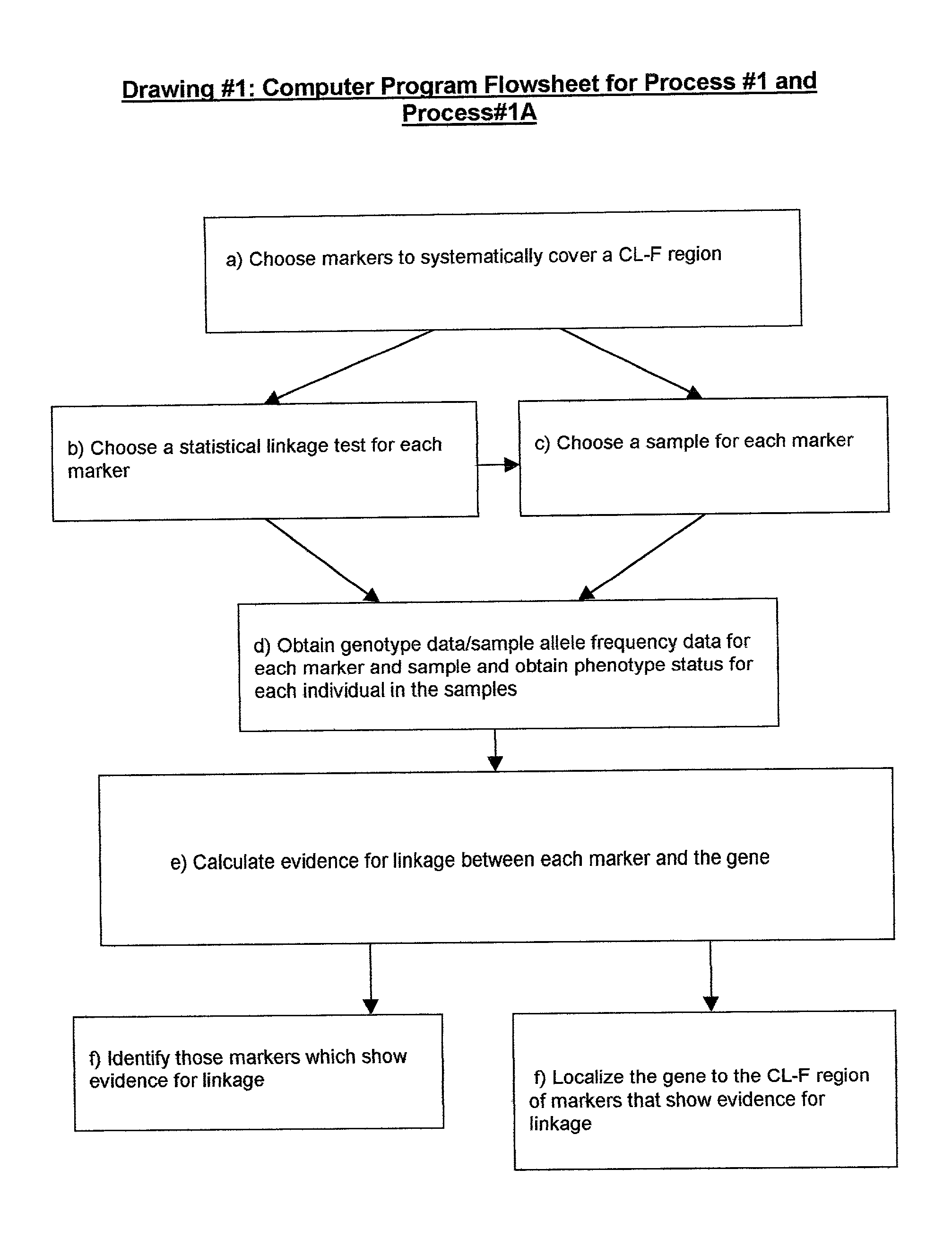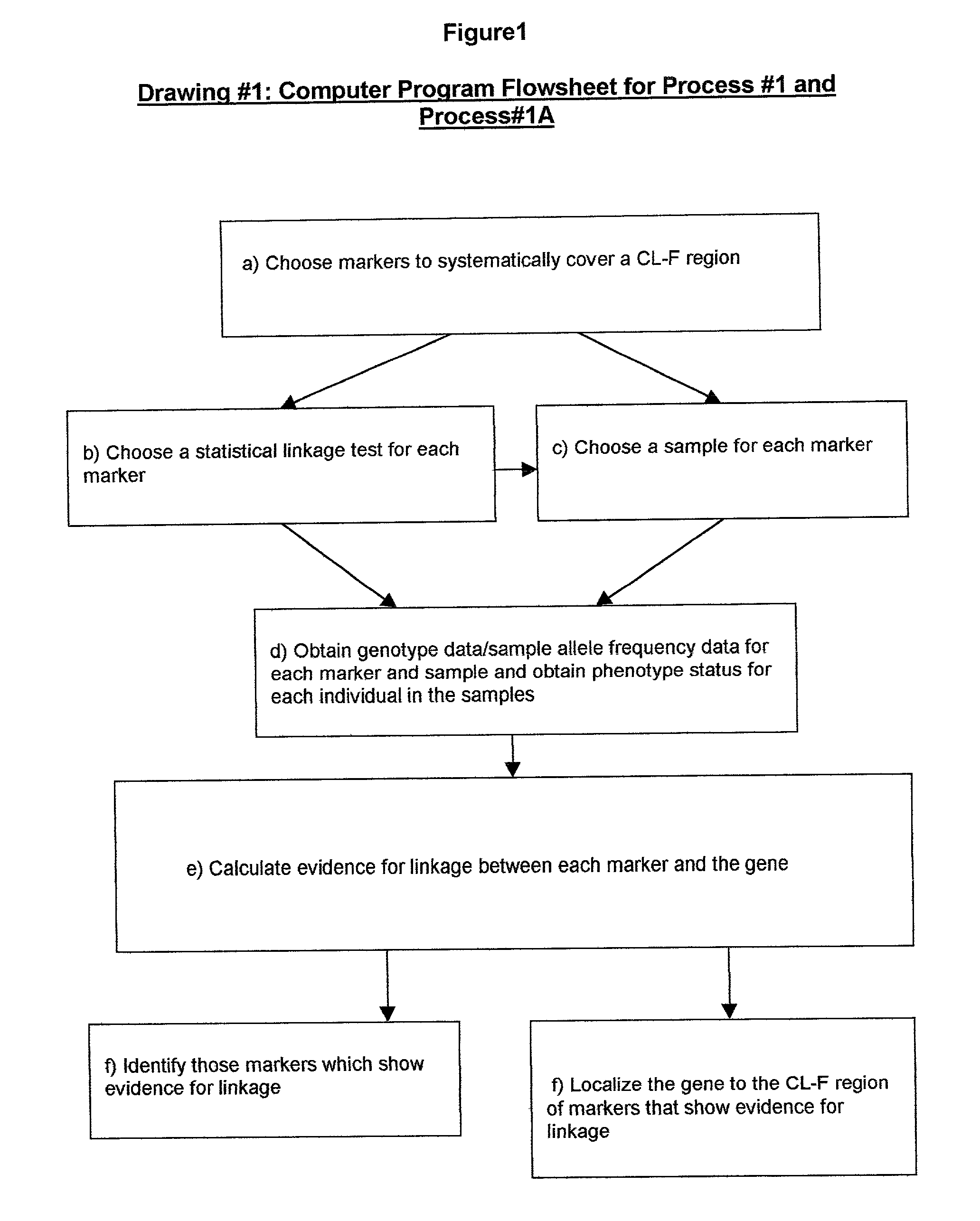Two dimensional linkage study methods and related inventions
a linkage study and two-dimensional technology, applied in the field of two-dimensional linkage study methods, can solve the problems of unfavorable bi-allelic markers with less common allele frequencies, unfavorable bi-allelic markers, and limited power to localize trait-causing genes (trait-causing polymorphisms)
- Summary
- Abstract
- Description
- Claims
- Application Information
AI Technical Summary
Benefits of technology
Problems solved by technology
Method used
Image
Examples
example 2
of ApparatusGd / Safd#1
[0225] An apparatus for obtaining genotype data / sample allele frequency data for each bi-allelic marker of a group of two or more bi-allelic covering markers in the chromosomal DNA of an individual, wherein the genotype data / sample allele frequency data is genotype data, comprising:
[0226] a) means for determining information on the presence or absence of each allele of each bi-allelic marker of a group of two or more bi-allelic covering markers in the chromosomal DNA from an individual, a CL-F region being N covered to within the CL-F distance [12 cM, 0.25] or the equivalent thereof by the two or more bi-allelic covering markers, wherein N is an integer number greater than or equal to 1; and
[0227] b) means for transforming the information of a) into genotype data for each marker of the group.
[0228] (It should be noted that the following genotype apparatus is equivalent to Example 2 of ApparatusGd / Safd#1: Genotype Apparatus: An apparatus for genotyping an individ...
example 1
of ProcessGd / Safd#1
[0239] A process for obtaining genotype data / sample allele frequency data for each bi-allelic marker of a group of two or more bi-allelic covering markers in the chromosomal DNA of an individual, wherein the genotype data / sample allele frequency data is genotype data, comprising:
[0240] a) determining information on the presence or absence of each allele of each bi-allelic marker of a group of two or more bi-allelic covering markers in the chromosomal DNA from an individual, a CL-F region being N covered to within the CL-F distance [12 cM, 0.25] or the equivalent thereof by the two or more bi-allelic covering markers; wherein N is an integer number greater than or equal to 1;and
[0241] b) transforming the information of a) into genotype data for each marker of the group.
[0242] (It should be noted that the following genotype process is equivalent to Example 1 of ProcessGd / Safd#1: Genotype Process: A process for genotyping an individual, comprising:
[0243] a) genotypin...
example 1s
of Use set#1D
[0263] The use in genotyping one or more individuals, of one or more copies of a set of oligonucleotides, the set of oligonucleotides being complementary to a group of two or more bi-allelic covering markers, a CL-F region being N covered by the covering markers to within a CL-F distance of about [250,000 bp, 0.1] or the equivalent thereof, wherein N is an integer greater than or equal to two.
[0264] Composition of Matter: Description of Comp set#1D
[0265] Comp set#1D: One or more copies of a set of oligonucleotides, the set of oligonucleotides being complementary to a group of two or more bi-allelic covering markers, wherein the group of covering markers systematically cover a CL-F region.
[0266] A set of oligonucleotides that is complementary to a group of two or more bi-allelic covering markers, wherein the group of covering markers systematically cover a CL-F region has great utility for use in the two-dimensional linkage study techniques introduced in this application...
PUM
| Property | Measurement | Unit |
|---|---|---|
| frequency | aaaaa | aaaaa |
| physical (genetic) characteristics | aaaaa | aaaaa |
| physical characteristics | aaaaa | aaaaa |
Abstract
Description
Claims
Application Information
 Login to View More
Login to View More - R&D
- Intellectual Property
- Life Sciences
- Materials
- Tech Scout
- Unparalleled Data Quality
- Higher Quality Content
- 60% Fewer Hallucinations
Browse by: Latest US Patents, China's latest patents, Technical Efficacy Thesaurus, Application Domain, Technology Topic, Popular Technical Reports.
© 2025 PatSnap. All rights reserved.Legal|Privacy policy|Modern Slavery Act Transparency Statement|Sitemap|About US| Contact US: help@patsnap.com



